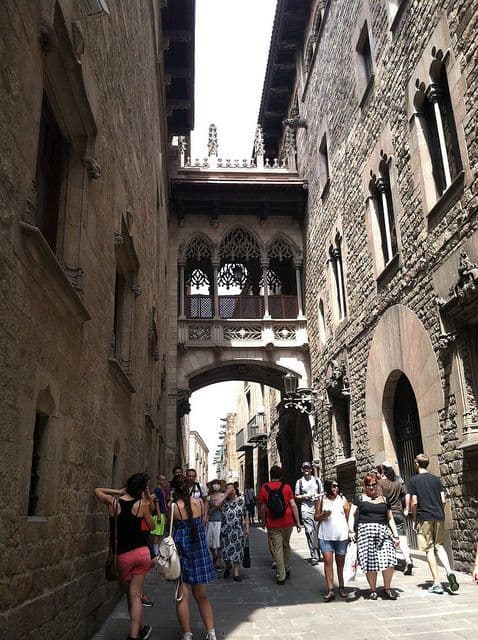
One of my favorite places in Barcelona is Barri Gotic, or the Gothic quarter of town. It’s so astounding and unusual in that it is so well preserved – you feel as though you’ve stepped back in time and are walking through Medieval streets and alleys, and only the people in modern garb and souvenir vendors break the illusion. Apparently the entirety of the quarter isn’t preserved from these pre-Modern times, as there have been restorations and additions made throughout the 20th and 19th centuries, but there are structures as old as the Roman empire itself.
The Barri Gotic is found in the Ciutat Vella, or “old city” part of town. It’s definitely a place you can devote a whole day to, whether through getting lost in its narrow, meandering passageways and popping into the various shops, or through exploring the various churches and museums in the area. You can also crouch down by a wall and be serenaded by the various musical performers you may find around corners, or in the plazas you’ll stumble upon.
One of the more impressive sites in the quarter is the Barcelona Cathedral. Built between the 13th and 15th centuries, it’s a very grand Gothic architectural affair complete with towering ceilings, pointed arches, and massive ribbed vaults. The exterior is the one part built in the 19th century, though still in the Gothic style (and so, neo-Gothic), and no less striking. For a fair price of six euros you can enter the cathedral, which at first leads into a curious looking cloister surrounding an uncovered square in the center that contains a thicket of palm trees and fountains. It was probably the sight of a mini forest of sorts in the middle of this cathedral from the entrance that drew me in initially. Among the fountains you will even see geese waddling about. Walking around the cloister you will find several alcoves containing elaborate relics. But the highlight is the interior of the cathedral, which upon entrance inevitably prompts a chorus of low gasps and “Wow.” Massive columns, great domed ceilings and the characteristic Gothic features swimming in a haunting, darkened light make for a beautiful and ineffable setting. You just can’t beat European cathedrals, and Barcelona Cathedral became one of my favorites that day. After you make your rounds exploring the interior, you can take an elevator to the top of the structure and take in some rooftop views of the outer spires and towers, and the surrounding Barri Gotic. As another draw to the Cathedral, on Sunday afternoons in the square right in front of the main entrance locals gather to dance the Catalan national dance, la sardana. I wasn’t able to catch the dance myself, but from the looks of youtube videos it looks like a lot of fun to watch the often older citizens joining hands and getting down!
If you’re particularly into history, I would also recommend visiting the Barcelona City History Museum. The museum comprises multiple sites throughout the city, though the main headquarters is in the Barri Gothic. Here you get to learn about some more things you probably didn’t know about the city, like how it was founded as a Roman colony called Barcino. Even cooler is how you get to walk through preserved Roman ruins of the town, which are laid exactly as they once were thousands of years ago. Learn some fun facts about the Roman wine making process and the vats they made it in, where they stored their fish and how they did their laundry, in which urine was often used as a detergent. Fun facts!
If you still have time in the day (as I did), you can make the short walk to the Picasso Museum which is on the fringes of the Barri Gotic. Initially I passed right by the museum in the narrow street not realizing what it was, which shows how blended in to the surrounding Gothic architecture it is. The museum itself (free for students, by the way) is excellent as you might expect, and in particular focuses on Picasso’s early years, much of which were spent in Barcelona. Personally the highlights for me were the endless renditions and recreations Picasso did of the famous Las Meninas painting by the great Spanish 17th century painter Diego Velazquez. In typical abstract and colorful fashion, Picasso reinterprets and remakes the painting in his own style, at times focusing on only a few figures in smaller portraits, or redoing the entire thing on bigger canvases. I was interested in how he would treat the figure of Velazquez himself, who paints himself painting in the painting (say that 3 times fast), as well as the mysterious mirror in the back reflecting the king and queen of Spain. I’m fairly certain the depiction of the original work wasn’t shown for comparison at the museum, so if you aren’t familiar with it, take a look below.
In short, wander around the alleyways, pop into random churches, marvel at the Roman walls and immerse yourself in the bustling atmosphere of the Barri Gotic. It’s such a unique and bizarre place, and one of the best parts of Barcelona.